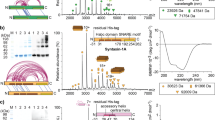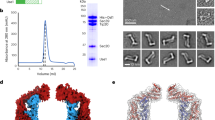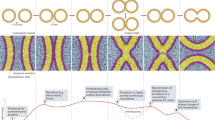Abstract
In the eukaryotic secretory and endocytic pathways, transport vesicles shuttle cargo among intracellular organelles and to and from the plasma membrane. Cargo delivery entails fusion of the transport vesicle with its target, a process thought to be mediated by membrane bridging SNARE protein complexes. Temporal and spatial control of intracellular trafficking depends in part on regulating the assembly of these complexes. In vitro, SNARE assembly is inhibited by the closed conformation adopted by the syntaxin family of SNAREs. To visualize this closed conformation directly, the X-ray crystal structure of a yeast syntaxin, Sso1p, has been determined and refined to 2.1 Å resolution. Mutants designed to destabilize the closed conformation exhibit accelerated rates of SNARE assembly. Our results provide insight into the mechanism of SNARE assembly and its intramolecular and intermolecular regulation.
This is a preview of subscription content, access via your institution
Access options
Subscribe to this journal
Receive 12 print issues and online access
$189.00 per year
only $15.75 per issue
Buy this article
- Purchase on Springer Link
- Instant access to full article PDF
Prices may be subject to local taxes which are calculated during checkout







Similar content being viewed by others
Accession codes
References
Jahn, R. & Südhof, T.C. Membrane fusion and exocytosis. Annu. Rev. Biochem. 68, 863–911 (1999).
Weimbs, T., et al. A conserved domain is present in different families of vesicular fusion proteins: a new superfamily. Proc. Natl. Acad. Sci. USA 94, 3046–3051 (1997).
Hanson, P.I., Otto, H., Barton, N. & Jahn, R. The N-ethylmaleimide-sensitive fusion protein and α-SNAP induce a conformational change in syntaxin. J. Biol. Chem. 270, 16955–16961 (1995).
Poirier, M.A., et al. The synaptic SNARE complex is a parallel four-stranded helical bundle. Nature Struct. Biol. 5, 765–769 (1998).
Sutton, R.B., Fasshauer, D., Jahn, R. & Brunger, A.T. Crystal structure of a SNARE complex involved in synaptic exocytosis at 2.4 Å resolution. Nature 395, 347–353 (1998).
Katz, L., Hanson, P.I., Heuser, J.E. & Brennwald, P. Genetic and morphological analyses reveal a critical interaction between the C-termini of two SNARE proteins and a parallel four helical arrangement for the exocytic SNARE complex. EMBO J. 17, 6200–6209 (1998).
Weber, T., et al. SNAREpins: minimal machinery for membrane fusion. Cell 92, 759–772 (1998).
Bennett, M.K., Calakos, N. & Scheller, R.H. Syntaxin: a synaptic protein implicated in docking of synaptic vesicles at presynaptic active zones. Science 257, 255–259 (1992).
Fernandez, I., et al. Three-dimensional structure of an evolutionarily conserved N-terminal domain of syntaxin 1A. Cell 94, 841–849 (1998).
Misura, K.M.S., Scheller, R.H. & Weis, W.I. Three-dimensional structure of the neuronal–Sec1-syntaxin complex. Nature 404, 355–362 (2000).
Calakos, N., Bennett, M.K., Peterson, K.E. & Scheller, R.H. Protein-protein interactions contributing to the specificity of intracellular vesicular trafficking. Science 263, 1146–1149 (1994).
Nicholson, K.L., et al. Regulation of SNARE complex assembly by an N-terminal domain of the t-SNARE Sso1p. Nature Struct. Biol. 5, 793–802 (1998).
Fiebig, K.M., Rice, L.M., Pollock, E. & Brunger, A.T. Folding intermediates of SNARE complex assembly. Nature Struct. Biol. 6, 117–123 (1999).
Dulubova, I., et al. A conformational switch in syntaxin during exocytosis: role of munc18. EMBO J. 18, 4372–4382 (1999).
Scales, S.J., et al. SNAREs contribute to the specificity of membrane fusion. Neuron 26, 457–464 (2000).
Aalto, M.K., Ronne, H. & Keränen, S. Yeast syntaxins Sso1p and Sso2p belong to a family of related membrane proteins that function in vesicular transport. EMBO J. 12, 4095–4104 (1993).
Carr, C.M., Grote, E., Munson, M., Hughson, F.M. & Novick, P.J. Sec1p binds to SNARE complexes and concentrates at sites of secretion. J. Cell Biol. 146, 333–344 (1999).
Waters, M.G. & Hughson, F.M. Membrane tethering and fusion in the secretory and endocytic pathways. Traffic 1, 588–597 (2000).
Lerman, J.C., Robblee, J., Fairman, R. & Hughson, F.M. Structural analysis of the neuronal SNARE protein syntaxin-1A. Biochemistry 39, 8470–8479 (2000).
Carr, C.M. & Novick, P.J. Membrane fusion: changing partners. Nature 404, 347–349 (2000).
Parlati, F., et al. Rapid and efficient fusion of phospholipid vesicles by the alpha-helical core of a SNARE complex in the absence of an N-terminal regulatory domain. Proc. Natl. Acad. Sci. USA 96, 12565–12570 (1999).
Betz, A., Okamoto, M., Benseler, F. & Brose, N. Direct interaction of the rat unc-13 homologue Munc13-1 with the N terminus of syntaxin. J. Biol. Chem. 272, 2520–2526 (1997).
Rossi, G., Salminen, A., Rice, L.M., Brünger, A.T. & Brennwald, P. Analysis of a yeast SNARE complex reveals remarkable similarity to the neuronal SNARE complex and a novel function for the C terminus of the SNAP-25 homolog, Sec9. J. Biol. Chem. 272, 16610–16617 (1997).
Rice, L.M., Brennwald, P. & Brünger, A.T. Formation of a yeast SNARE complex is accompanied by significant structural changes. FEBS Lett. 415, 49–55 (1997).
Brennwald, P., et al. Sec9 is a SNAP-25-like component of a yeast SNARE complex that may be the effector of Sec4 function in exocytosis. Cell 79, 245–258 (1994).
Finger, F.P. & Novick, P. Spatial regulation of exocytosis: lessons from yeast. J. Cell Biol. 142, 609–612 (1998).
Fasshauer, D., Eliason, W.K., Brunger, A.T. & Jahn, R. Identification of a minimal core of the synaptic SNARE complex sufficient for reversible assembly and disassembly. Biochemistry 37, 10354–10362 (1998).
Fasshauer, D., Bruns, D., Shen, B., Jahn, R. & Brünger, A.T. A structural change occurs upon binding of syntaxin to SNAP-25. J. Biol. Chem. 272, 4582–4590 (1997).
Yang, B., Steegmaier, M., Gonzalez, L.C. & Scheller, R.H. nSec1 binds a closed conformation of syntaxin1A. J. Cell Biol. 148, 247–252 (2000).
Fasshauer, D., Antonin, W., Margittai, M., Pabst, S. & Jahn, R. Mixed and non-cognate SNARE complexes. J. Biol. Chem. 274, 15440–15446 (1999).
Novick, P., Field, C. & Schekman, R. Identification of 23 complementation groups required for post-translational events in the yeast secretory pathway. Cell 21, 205–215 (1980).
Novick, P. & Zerial, M. The diversity of Rab proteins in vesicle transport. Curr. Opin. Cell Biol. 9, 496–504 (1997).
Terbush, D.R., Maurice, T., Roth, D. & Novick, P. The Exocyst is a multiprotein complex required for exocytosis in Saccharomyces cerevisiae. EMBO J. 15, 6483–6494 (1996).
Yang, B., et al. SNARE interactions are not selective: implications for membrane fusion specificity. J. Biol. Chem. 274, 5649–5653 (1999).
Tsui, M.M. & Banfield, D.K. Yeast Golgi SNARE interactions are promiscuous. J. Cell Sci. 113, 145–152 (2000).
Guide to Native PAGE. Technical Literature #1822 (Bio-Rad Laboratories, Hercules, California; 1993).
Winzeler, E.A., et al. Functional characterization of the S. cerevisiae genome by gene deletion and parallel analysis. Science 285, 901–906 (1999).
Christianson, T.W., Sikorski, R.S., Dante, M., Shero, J.H. & Hieter, P. Multifunctional yeast high-copy-number shuttle vectors. Gene 110, 119–122 (1992).
Sikorski, R.S. & Hieter, P. A system of shuttle vectors and yeast host strains designed for efficient manipulation of DNA in Saccharomyces cerevisiae. Genetics 122, 19–27 (1989).
Leahy, D.J., Erickson, H.P., Aukhil, I., Joshi, P. & Hendrickson, W.A. Crystallization of a fragment of human fibronectin: introduction of methionine by site-directed mutagenesis to allow phasing via selenomethionine. Proteins 19, 48–54 (1994).
Otwinowski, Z. & Minor, W. Processing of x-ray diffraction data collected in oscillation mode. Methods Enzymol. 276, 307–326 (1998).
Terwilliger, T.C. & Berendzen, J. Automated structure solution for MIR and MAD. Acta Crystallogr. D 55, 849–861 (1999).
Collaborative Computational Project Number 4. The CCP4 suite: programs for protein crystallography. Acta Crystallogr. D 50, 760–763 (1994).
Jones, T.A., Zou, J.-Y., Cowan, S.W. & Kjeldgaard, M. Improved methods for building protein models in electron density maps and the location of errors in these models. Acta Crystallogr. A 47, 110–119 (1991).
Brunger, A.T., et al. Crystallography and NMR System (CNS): a new software system for macromolecular structure determination. Acta Crystallogr. D 54, 905–921 (1998).
Kraulis, P. MOLSCRIPT: a program to produce both detailed and schematic plots of protein structures. J. Appl. Crystallogr. 24, 924–950 (1991).
Esnouf, R.M. An extensively modified version of MolScript that includes greatly enhanced coloring capabilities. J. Mol. Graph. Model. 15, 132–134 (1997).
Carson, M. Ribbon models of macromolecules. J. Mol. Graph. 5, 103–106 (1987).
Acknowledgements
We thank J. Carey, C. Carr, L. Cavanaugh, E. Grote, R. Miller, S. Miller, P. Novick, B. Reilly, M. Rose, Y. Shi, and G. Waters for gifts of materials and for helpful advice. We are particularly grateful to J. Lerman for guidance in designing mutants and assistance in X-ray data collection. This work was supported by the American Heart Association (M.M.), the Searle Scholars and Beckman Young Investigators programs (F.M.H.), and the N.I.H. (M.M. and F.M.H.).
Author information
Authors and Affiliations
Corresponding author
Rights and permissions
About this article
Cite this article
Munson, M., Chen, X., Cocina, A. et al. Interactions within the yeast t-SNARE Sso1p that control SNARE complex assembly. Nat Struct Mol Biol 7, 894–902 (2000). https://doi.org/10.1038/79659
Received:
Accepted:
Issue Date:
DOI: https://doi.org/10.1038/79659
This article is cited by
-
The Habc domain of syntaxin 3 is a ubiquitin binding domain
Scientific Reports (2020)
-
Crystal structure of Sec10, a subunit of the exocyst complex
Scientific Reports (2017)
-
Sec3 promotes the initial binary t-SNARE complex assembly and membrane fusion
Nature Communications (2017)
-
Chaperoning SNARE assembly and disassembly
Nature Reviews Molecular Cell Biology (2016)
-
NMR analysis of the closed conformation of syntaxin-1
Journal of Biomolecular NMR (2008)



